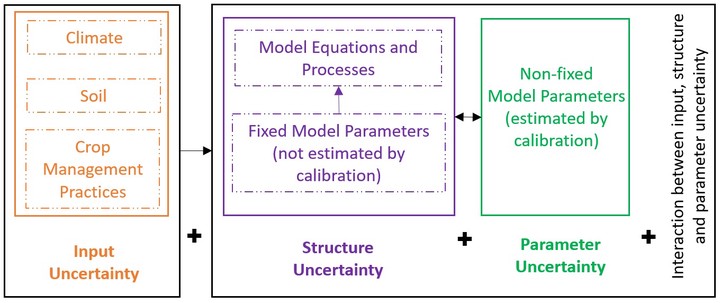Uncertainty decomposition in crop models
 Photo by Ranju Chapagain
Photo by Ranju ChapagainPhD Project: Estimating Uncertainty in Agricultural Crop Models
Crop models are an essential tool for simulating crop growth, development and yield at different scales (e.g. field, basin, region, national, global). Crop models produce actionable information on issues related to food security, climate change, land-use change, and market dynamics. Despite increasing importance and use, various sources of uncertainty exist in the modeling process due to the “impossibility to model the cropping system with complete determinism”. In this Ph.D. project, by uncertainty, we mean “any departure from the unachievable ideal of complete determinism”. Uncertainty exists in each step of the crop modeling processes. Observational data is imperfect and often non-standard, with varying sources over different spatial and temporal scales. This can lead to uncertainty surrounding inputs selected, but also has implications during model development (e.g. model structure) and tuning (e.g. model parameter selection). Hence, uncertainty can be grouped into three categories- a) observation uncertainty, b) prediction uncertainty and c) model uncertainty. These three categories of uncertainty are closely related but different from one another. Addressing these uncertainties is extremely important, as this will allow the user to better understand the level of confidence in the model outputs and select actionable practices accordingly. As such, this Ph.D. project focuses on the historical and current research gaps, trends and challenges in estimating uncertainty in crop modeling to answer the following research questions:
- Are temporal dynamics considered in model uncertainty assessments (e.g. future scenarios)? If so, is there a bias to assess future climate uncertainty?
- How does crop model uncertainty decompose? Does the decomposition follow any methodology? Does each assessment specify the model uncertainty source analyzed, and if so, which source of model uncertainty is considered? Are interactions between sources of uncertainties considered?
- Is there a predominance of studies assessing model uncertainty for a specific model output (e.g. crop yield)?
- Which statistics or mathematical approaches (e.g. Bayesian, ANOVA) are used to quantify the model uncertainties?
- Which key gaps exist in understanding, characterizing, and assessing crop model uncertainty? Which are the possible ways to reduce crop model uncertainty?
Parterns
University of Göttingen (Dr Ehsan Eyshi Rezaei), INRA (Dr Daniel Wallach)
PhD Student
Ranju Chapagain
Primary supervisor
Dr Jonathan Ojeda
Co-supervisors
Dr Harris R and Dr Remenyi T (Geography and Spatial Sciences-UTAS), Dr Huth N and Dr Brown J (CSIRO), Prof Mohammed C (TIA-UTAS).
Funded by
University of Tasmania and Australian Sustainable Agriculture Elite Scholarship (CSIRO-TIA/UTAS)
Grant amount
Total: AUD$303,226
- UTAS Tuition Fee: AUD$144,900
- Tasmania Graduate Research Scholarship living allowance: AUD$108,328
- Australian Sustainable Agriculture Elite Scholarship: AUD$49,998